Understanding SAP ISA-M Methodology
Understanding SAP ISA-M Methodology.
Integration has been fundamental to successful SAP implementation for decades. However, due to fast paced developments in architecture and technology, as well as a number of new solutions in Machine Learning, AI, Robotic Process Automation and other such areas, hybrid landscapes have become inevitable - hence the integration models. In an earlier blog, I discussed the Integration theme in detail. Looking simply for tools, such as “SAP Process Orchestration” for integration, may not be sufficient in the current context. It has become imperative to have a standardised “self-service-integration” as a type of “business utility” to continuously integrate the ever-increasing hybrid landscapes in every organisation.
SAP has always provided methodologies, like ASAP for SAP ERP implementation and Activate for current SAP solutions, as the customers' needs evolve. In a similar manner, SAP has articulated “Integration Solution Advisory Methodology” (ISA-M for short) for achieving standardisation in continuous integration needs. Let us try to understand ISA-M in this blog.
SAP ISA-M is a four-stage cycle, as can be seen below. The stages are pictorially depicted in Exhibit-1 below.
- Assess the Integration Strategy
- Design the Hybrid Integration Platform
- Define Integration Best Practices
- Enable a Practice of Empowerment
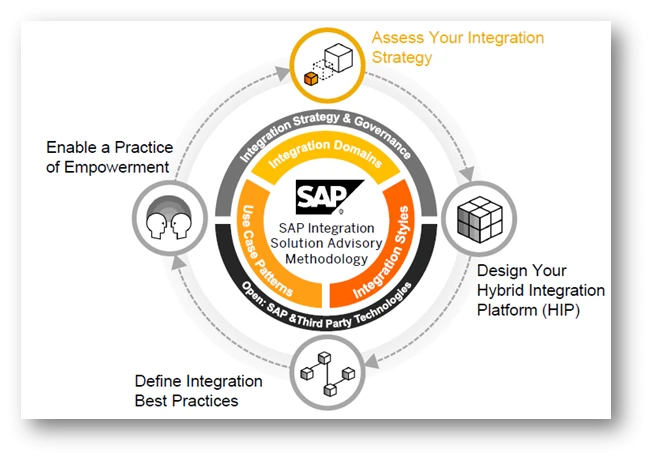
Exhibit -1 (Credits: SAP SE)
Assess Integration Strategy
Assessing the current integration strategy is the starting point. A review of the existing integration architecture is done with the objective to assess the current integration maturity level. The assessment also brings out the new focus areas in the context of organisations' future business plans. For example, there may be an upcoming new cloud applications implementation or moving to S/4 Hana and other such activities planned. The assessment also helps to consolidate integration technologies and bring in standardisation. Assessment is done using “use-case” driven approach, which is technology-agnostic.
There are three different steps in assessing the strategy:
- Understand Integration Domains
- Identify Integration Styles
- Scope Use-Case Patterns
1. Understand Integration Domains
In a hybrid landscape, typical integration areas form an Integration Domain. For example, there are applications like Success factor, Fieldglass in cloud domain; S/4Hana or custom-built non-SAP applications in On Premise domain; mobile apps and desktop apps in user-centric domain; IoT based devices in real world objects. Hence the Integration between any two of these domains forms an “integration domain”. For example, User2Cloud or OnPremise2Cloud are examples of Integration domain. An architect would detail out an “as-is” and “to-be” scenarios based on this.
Pictorially it is defined in exhibit-2 below.

Exhibit-2 ( Credits: SAP SE)
2. Identify Integration Styles
Integration Styles are the basic types of integration between any two systems. ISA-M defines 5 types of integration styles. They are explained briefly in exhibit-3 below.
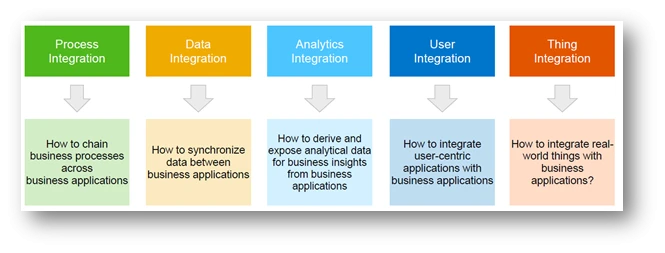
Exhibit-3 (Credits : SAP SE)
Characteristics of each integration style varies. They are explained briefly in exhibit-4 below.
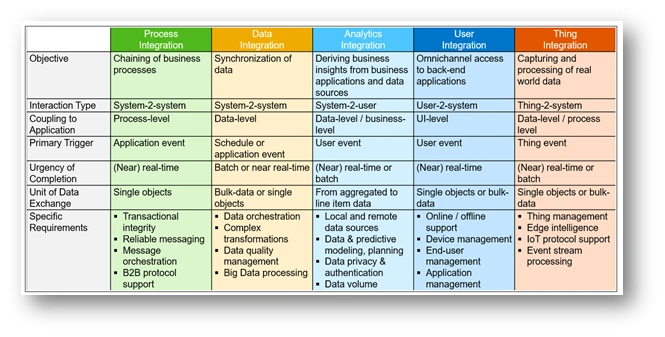
Exhibit-4 (Credits: SAP SE)
The architect, based on various technical requirements of the situation, chooses the appropriate style.
3. Scope Use-Case Patterns
There are many use-cases common in every enterprise. Use-cases in each of the above-mentioned Integration Styles fall in to certain patterns. SAP has grouped and called them “Use-case Patterns”. Use cases are independent of the technology used to implement them. ISA-M templates are provided as a library of Use-case patterns for ready use. Certain use case patterns which cannot be mapped only to a single integration style are grouped under “cross-use cases pattern”. They are depicted in exhibit-5 below.

Exhibit-5 (Credits: SAP SE)
The architect identifies the relevant use-case patterns for the organisation.
Design the Hybrid Integration Platform
Designing the hybrid integration Platform involves mapping of the use case patterns to the Integration Technologies and Services. The use of third-party integration services or SAP integration services in SAP Cloud Platform Integration Suite must be decided at this stage. There are more than 160+ out of the box connectors to even non-SAP applications which are available in cloud platform Integration suite. There are three steps involved in designing the platform as given below.
- Technology Mapping
- Integration Scenario Discovery
- Interface Selection
1. Technology Mapping
In this step, the architect maps the relevant integration technologies and services for the identified use case patterns in previous cycle stage. While use case patterns are technology agnostic, the integrations/services are technology specific. An enterprise architect may have to combine many technologies like Platform as service, IoT Platform and so on. This is highly dependent on the customer specific situation and requirements. The architect details an integration guideline for future use during this step. The exhibit-6 below, pictorially represents a overview of mapping.
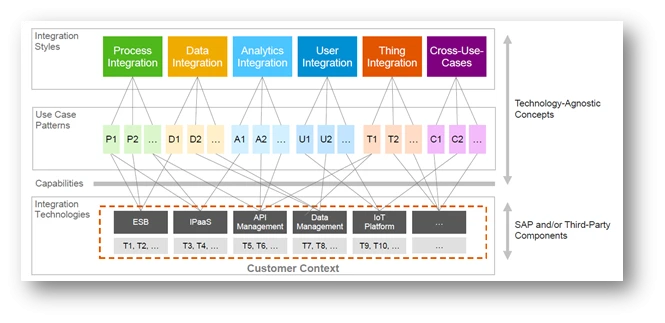
Exhibit-6 (Credits: SAP SE)
2. Integration Scenario Discovery
In this step, the architect explores the available out-of-the-box integrations. For customer specific requirements, a customer driven integration could be developed by an in-house team or system integrators. The characteristics of these two approaches and benefits are given in exhibit-7 below.
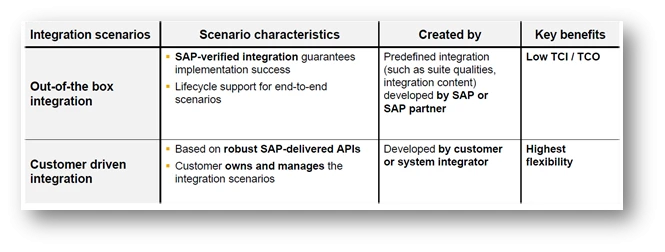
Exhibit-7 (Credits: SAP SE)
3. Interface Selection
This is a highly technical subject handled the architect. API forms a key building block for data transmissions as an interface. Choosing the right type of interface, like Synchronous Vs Asynchronous, is an important technical decision based the different requirements of the customer. SAP API hub provides many whitelisted web-based API’s. A simple example is provided below to demonstrate an interface selection in exhibit-8

Exhibit-8 (Credits : SAP SE)
Define Integration Best Practices
Defining Integration best practices is the foundation to repeatedly create successful implementations in an efficient manner. It helps to govern and safeguard implementation of integrations uniformly across the organisation bringing transparency in design and implementation. It is a four-step process:
- Defining Integration Do’s and Don’ts
- Creating architecture Blueprints
- Leveraging Integration Templates
- Preparing Integration Guidelines
1. Defining Integration Do’s and Don’ts
The architect along with team members must brainstorm and define mandatory and optional integration style specific do’s and don’ts. They must also define a set of essential integration development standards. A sample do’s and don’ts for Process Integration style is shown in exhibit-9 below.
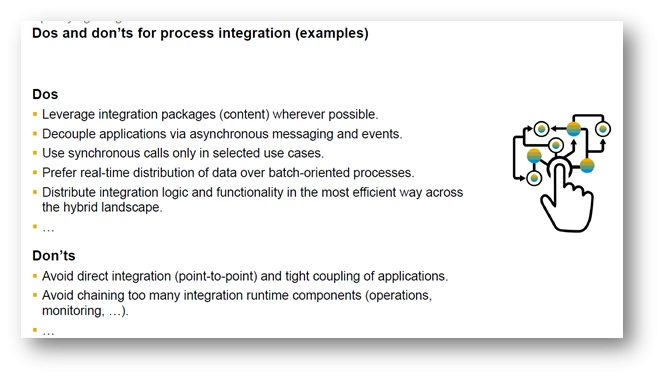
Exhibit-9 (Credits: SAP SE)
2. Creating Architecture Blueprints
Architecture Blueprints are the “How to's’" of implementing integration scenarios. They serve as references to identify which integration technologies to choose, how to orchestrate when several integration technologies are involved and how to integrate with business applications. The relevant decision criteria, when and how to apply the blueprint, are all part of the architecture Blueprint. ISA-M templates provide sample architecture blueprints leveraging SAP Integration technologies. An example info sheet for mobile integration scenario is given in exhibit-10 below.

Exhibit-10 (Credits: SAP SE)
3. Leveraging Integration Templates
SAP has provided pre-defined integration templates for SAP Integration technologies, such as SAP Cloud Platform Integration Suite, SAP Data Intelligence and so on. Using these templates, standardises and speeds up the implementation. The objective is not to "reinvent the wheel”.
4. Prepare Integration Guidelines
Guidelines must be developed covering all areas such as design, security roles, data privacy & protection, operations error handling & monitoring, naming conventions for developed artefacts and so on. An example of guidelines to implement specific integration patterns in the context of SAP Cloud Platform Integration suite is given in exhibit-11 below.
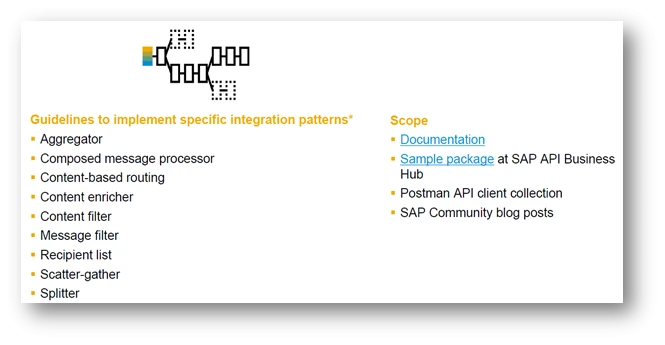
Exhibit-11 (Credits: SAP SE)
Enable a Practice of Empowerment
At this stage, the organisation must establish “Integration” as a discipline. A good knowledge-sharing culture must be instituted, specifically for Integration discipline. The organisation must set up an agile integration practice model and democratise the Integration delivery. This is a three-step process:
- Institutionalise Integration Roles
- Establish Integration Centre of Excellence
- Introduce Integration Governance and Quality Assurance
1. Institutionalise Integration Roles
Depending on organisational size, a set of new “Integration specific” roles have to be created and managed. If an organisation is large enough e.g. multinational corporations, creating a role of “Chief Integration Officer” may also be required. A sample set of roles are depicted in exhibit-12 below.
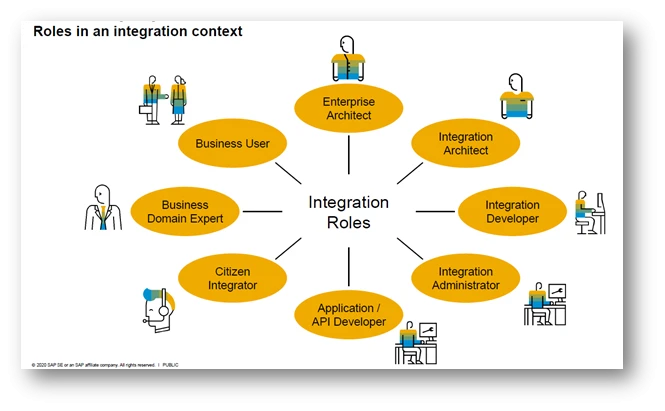
Exhibit-12 (Credits: SAP SE)
An example of responsibilities of certain roles is provided below in exhibit-13.
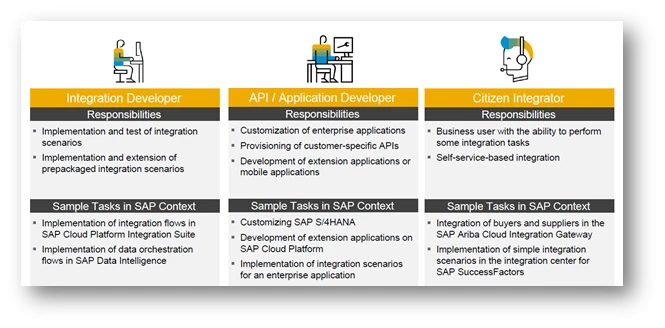
Exhibit-13 (Credits: SAP SE)
2. Establishing an “Integration Centre of Excellence”
The ICoE could be established in a Centralised, Federated or Distributed manner, depending on the size and nature of the organisation. There could be other models an organisation can arrive at considering the nature of their business. Exhibit-14 below shows the models pictorially.
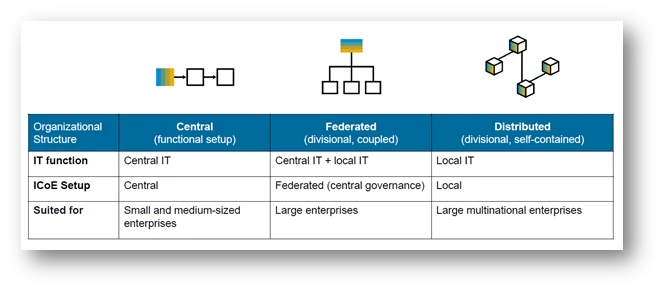
Exhibit-14 (Credits: SAP SE)
The following exhibit-15 briefly shows the high-level overview of ICoE responsibilities.

Exhibit-15 (Credits: SAP SE)
3. Introduce Integration Governance and Quality Assurance
Governance and QA are important functions to ensure that the conceptual thoughts translate into reality in a business-centric manner. Agile quality assurance processes must be put in place to ensure basic (meets end-user expectations, etc) and Mandatory (protect organisation from legal and technology risks, etc) needs of the organisation. A simplified example of integration governance framework is provided in exhibit-16 below
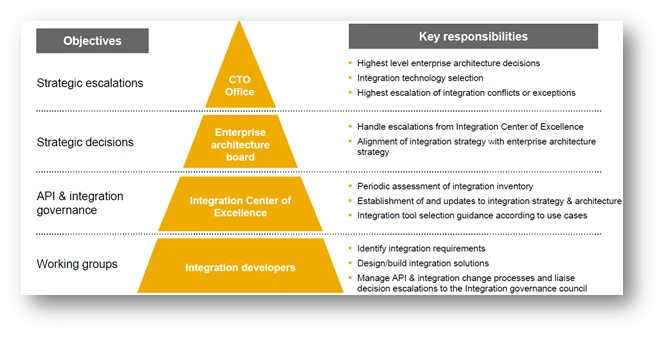
Exhibit-16 (Credits: SAP SE)
Summary
As is the present reality of organisations using multiple technologies, rapidly developing hybrid landscapes is a reality. This is a huge challenge for CIOs and business competitiveness forces more of these to happen. Using ISA-M methodology, organisations can build integration competencies and a technology agnostic framework to define and successfully execute an integration strategy. SAP also offers an “SAP integration strategy service” for SAP Premium Engagement Customers. The new Integration roles are a boon for seasoned SAP Consultants and Architects, to bring more value to the table.
References: